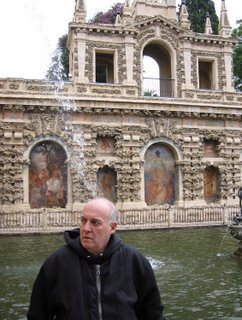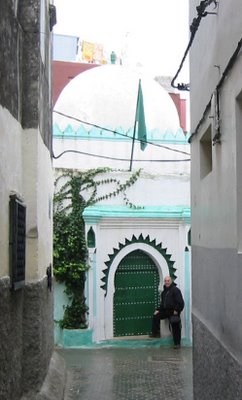
Once I get settled into this blog I'm sure it'll set its own rhythm. It won't be all chronological or anything like that. But yesterday I got home from 3 weeks in Morocco and for now that's what I want to write about. I took some notes while I was there and after a while maybe some reflections'll come to me too. But today I want to write about Fes, long one of my favorite Moroccan cities (although the first time I visited, July, 1969, I was too intestinally-afflicted to pay it much attention; and food was the
last thing I was thinking about at the time). But I've been back many times and I was looking forward to it when I arrived from Tangier in late December (2005).
You can ask anyone in Morocco. Either they'll admit right off the bat that Fes has the best eats in the country or they'll make a tepid claim for their own city, asserting it
and Fes are the title holders. But-- despite the fact that Hassan II hired a Meknesi chef for his kids' weddings-- everyone knows the best food in Morocco, a country with a highly sophisticated and unique cuisine, is made in Fes. Problem is, it's not easily available to visitors.
First a disclaimer: individual Fassi can be as nice and as helpful and as generous and as kind as people anywhere-- or as selfish, predatory and rotten. But it seems that Fes as a corporate body, particularly as a part of the Moroccan tourist industry, views (Western) visitors as fat pigeons brought to them for plucking. In the capital of Moroccan cuisine there is virtually no place to get a decent meal! The hotels and virtually all the restaurants serve blanded out versions of Moroccan classics for astronomical prices in absurd, gawdy atmospheres that even include the distinctly non-Moroccan (let alone Fassi) tradition of belly dancers. It's all about huge portions and they don't know from
ala carte-- only ridiculously immense feasts (which are also ridiculously overpriced).
Like in any country, the best cooking is always in homes and because I've eaten in Moroccan homes for years, I know the difference between what is quality and what is swill. Heaping mounds of robotically-prepared mediocre food don't impress me even if it's served in a stunning atmosphere.
I stayed at the best address in Fes, the
Palais Jamai, a place I've stayed for decades, although this was the first visit since it was acquired by multinational Sofitel in 1999. A glorious era that began in 1930 has definitely come to an end. The hotel was never really inexpensive but Sofitel has not only made it blander and more acceptable to a lower common denominator (i.e.- people who like Disneyworld), they have also made it outrageously more expensive. I mean, although it is quite lovely, built into the walls of Fes-el-Bali (the old city medina), when you get right down to it, it is, afterall, just a nice old hotel afloat in a sea of donkey shit. Literally. (One of the principal charms of Fes-- less charitable people might say the
only charm-- is that it is a mysterious warren on dark, narrow cobblestone alleyways, with steps everywhere. It is the world's most complete functioning medieval city. No motor vehicles in medieval cities; only donkeys. And mules. And they don't wear diapers. After a while it only bothers you when it's raining.) Anyway, the hotel is charging London and Paris prices-- in a sea of donkey shit.
For those prices you should at least expect top notch eats, right? Breakfast's included and the key word is
bland. If a Moroccan wife served her husband's guests
harira like they had at breakfast at the Palais Jamai, she would be beaten before she was divorced.
A good price for GREAT harira (the national soup, the pride of every kitchen in the country) in a middle class Moroccan restaurant in Tangier is 5 dirhams. At the Jema el Fna in Marrakech, at one of the stalls, a heaping bowl of A-1 harira costs 2.5 dirham (like 30 U.S. cents). In tourist land-- not just in Fes, but in any Moroccan city catering to tourists-- the harira is of distinctly inferior quality and costs as much as 12 times that! A friend of mine from Meknes warned me-- as have other Moroccans outside of the tourist trade-- that if they think you're not Moroccan, the only limit to what they'll charge is what they think they can get away with. (Sounds something like Bush-Enron economics!)
According to the guide books, the "best" restaurant in Fes is the Al Fassia in our hotel. It is a very flashy atmosphere and the food is good. But there is no
ala carte menu, just the absurd dinner made for a glutton (for around $50/person, an immense sum in this country). When I explained to Jamal, the concierge, that we wanted real Fassi food, not a touristic feeding station farce, he recommended L'Arabesque, a few steps away from the hotel. (Good concierges try to listen to what their client is saying and come up with a solution. In Morocco, concierges are not working for you; they're working for whomever is paying them to send rich foreigners their way.) L'Arabesque is the same kind of overdone nonsense as the Al Fassia-- and even
more expensive! I'd wager no Moroccan has ever eaten there. And down the street-- and owned by the same outfit-- is the less grandiose joint along similar lines charging around $15/person, the Dar Jamaii. Dinner was somewhat better than canned dog food.
None of the tour books' highly recommended grand restaurants are open for dinner-- only lunch. We tried the Palais M'Nebhi, just me and Roland and a large troupe of picture-snapping Japanese. It is a beautiful setting-- all Moorish tiles and superbly carved ceilings and all-- but the food was remarkably mediocre-- and predictably overpriced. We were ready to give up on finding a good meal in the city with the best food in the country!
And along came Baba. Baba is a bizarre name for an Arab but this guy was born in Fes-- a former businessman whose stress-related heart problems led him away from business and towards calligraphy. Roland hired him to write the names of each of his 20 third graders in classic Arabic on exotic-looking cardstock. He recommended a restaurant called
Riad Dar Tafilalet. We walked over around 6, told them exactly what we wanted and they told us to come back at 9. I asked them to make me a tagine of the tiny black artichokes that were in season (
Tagine B'Lquoq beldi) that my friend from Meknes had told me about. Roland asked for a
lamb and prunes tagine. I got an exceptionally good vegetarian tagine-- no artichokes-- and Roland got some first rate lamb with artichokes; no prunes. There were no other clients but the staff was friendly and the atmosphere was fine and we ate the rest of our dinners at this place.
We also had a lunch with Baba and his family (in the house he was born in). Predictably it was better than anything we could get in a restaurant. Tons of food, though, and his sister-in-law and another guest kept urging me to eat more and more. No belching though.
I'll talk more about Fes and also more about Moroccan food-- in Tangier, Casablanca, Essaouira and Marrakech-- in a day or two. Meanwhile, here's a
great link for all the facts about Morocco.




















